Original URL: https://www.theregister.com/2012/05/08/review_intel_ivy_bridge_core_i7_3770k_quad_core_procesor/
Intel Ivy Bridge Core i7-3770K quad-core CPU
The generation game
Posted in Personal Tech, 8th May 2012 06:04 GMT
Review

Intel loves marketing jargon for most things it produces, and the company’s processor architecture roadmap is no different. In Intel speak, this moves along in "Tick-Tock" sequence. The Tock refers to a major revamp to the core architecture, while the Tick covers changes to the manufacturing process.
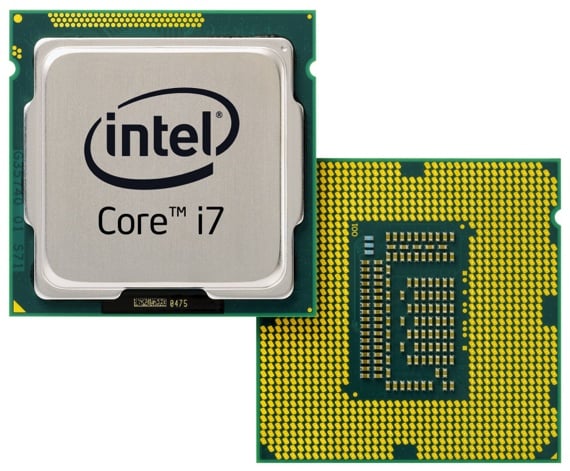
Chip off the old block
In the case of Ivy Bridge, then, it’s the Tick to the Tock of Sandy Bridge: the 32nm Sandy Bridge being shrunk down to become the 22nm Ivy Bridge. In the shops, the new processors are being labelled "third-generation Core i" by Intel.
When Intel announced Ivy Bridge, I knew it was just a matter of time before Mr Postie would drop a package on the doorstep with some new Core i goodness in it. The parcel contained a DZ77GA-70K motherboard and a nice new shiny Core i7-3770K to plug into it.
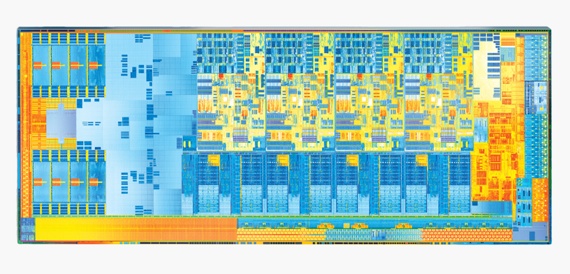
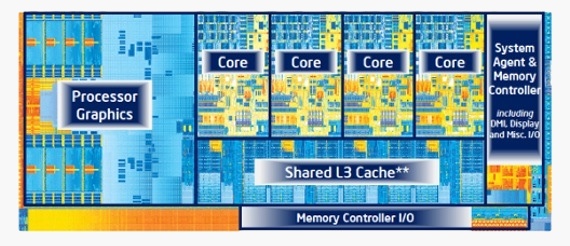
Die hard
The i7-3770K is the flagship of Intel's Ivy Bridge desktop range and as such is the replacement for the very popular Sandy Bridge Core i7-2700K part.
Like the 2700K, the 3770K is a quad-core design capable of processing eight threads thanks to HyperThreading. It has 8MB of "Smart" cache memory and is clocked at 3.5GHz which, with the aid of Intel’s Turbo Boost 2.0 technology, can be upped to 3.9GHz on the fly.
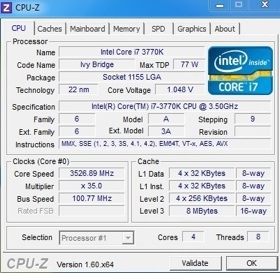
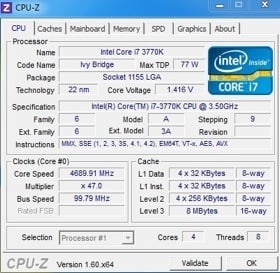
Ivy Bridge in CPU-Z: at stock speed (left) and overclocked to 4.7GHz (right)
Click for larger images
Notice the 'K' at the end of the product name? It’s an important letter that, meaning CPU comes with its multipliers unlocked which means one thing: easier overclocking.
What's the frequency, Kenneth?
And, just like the Sandy Bridge K chips, the 3770K is a doddle to overclock. Just by adjusting the Ratio Limits to 47 and using the stock 100MHz base clock, I got my sample to reach 4.7GHz and run stably at that speed on air cooling.
To compare the old and new, I lined up the i7-3770K against the Sandy Bridge Core i7-2600K, which I happened to have to hand and which is only 100MHz slower than the i7-2700K, the new chip's closest match in the Sandy Bridge series.
PC Mark 7

Longer bars are better
X264 v4

Figures in frames per second
Longer bars are better
Cinebench R11.5

Longer bars are better
Apart from the move to a 22nm process, the other important IVY Bridge improvement is the new integrated GPU. There are two versions: the HD 4000, which is for high-end CPUs like the 3770K, and the less powerful 2500, which is aimed at the middle of the market. Its most important feature is - drum roll please - Direct X 11 support, a feature that was noticeable by its absence in the Sandy Bridge graphics core, the HD 3000.
3DMark Vantage

Longer bars are better
DirectX 10

Average frames per second
Just Cause 2 Dark Map benchmark at Ultra settings, 4x FSAA
Longer bars are better
With the die shrink comes better power consumption, the TDP (Thermal Design Power) of the i7-3770K falling to 77W, some 18W less than the i7-2700K. This is quite something when you realise that both four-core parts share the same 3.5GHz clock speed.
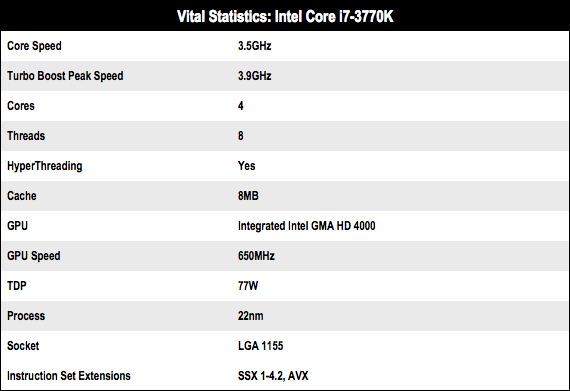
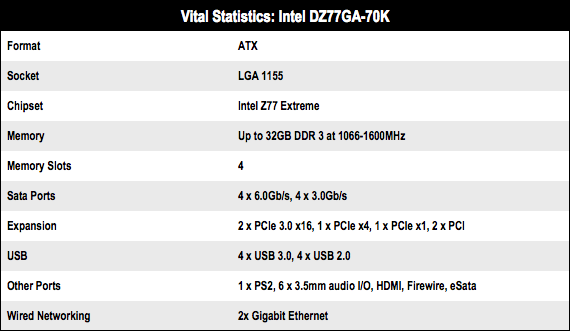
Board room shuffle
With a new processor, you obviously need something to stick it into, and I have here the DZ77GA-70K motherboard, part of the Intel's Extreme series of motherboards. Intel has a wide portfolio of boards - there are seven series that cover the desktop range alone, and there are other product lines for workstation and server use.
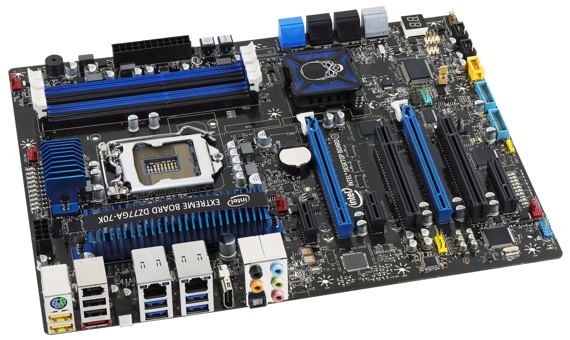
At last, SuperSpeed USB 3.0 ports. Hurrah!
There’s nothing eye-opening about the DZ77GA-70K, apart from the Bios, but more on that in a minute. It’s a typically stable high-end Intel board. It’s based around the new Z77 Express chipset which brings native support for USB 3.0 - finally!!! - along with PCI Express 3.0, provided there’s an Ivy Bridge CPU sitting in the socket.
It’s a tidy looking board, well laid out with separate passive coolers on the chipset and the power components with two PCIe 3.0 x16 (x16/x8) slots, single PCIe x4 and x1 slots, and two standard PCI slots for expansion purposes. For storage there are four 6Gb/s and four 3Gb/s Sata ports, which are all mounted at 90° on the edge of the board.
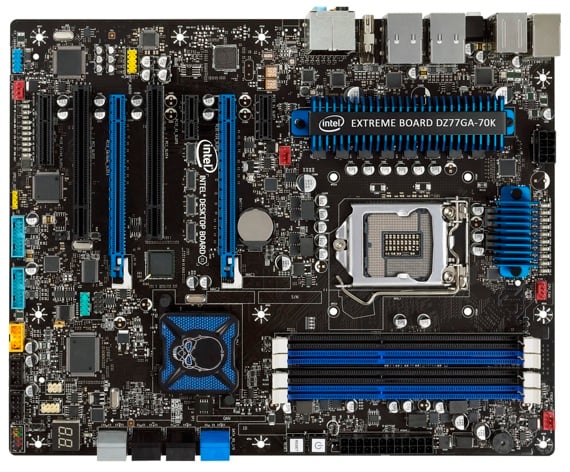
Intel's DZ77GA-70K has no shortage of expansion slots
The new Intel Visual Bios is a revelation and even gives Asus and Gigabyte - which have some of the easiest to access UEFI Bioses around - a good run for their money. UEFI (Unified Extensible Firmware Interface) has been around for a while. For those not in the know, it uses a GUI instead of the text interface and does way with the need to use the keyboard, instead allowing the use of a mouse, Yes, a mouse. Or a touchscreen even, it'll support that too.
Verdict

The Ivy Bridge Core i7-3770K doesn't make a giant leap ahead of the previous generation of Core i7 chippery. It’s more of gentle step forward. But the die shrink down to 22nm does make for a far more power efficient chip than the previous generation - good for your leccy bills - and at last Intel’s integrated graphics supports DirectX 11, something it has needed to do for quite some time. ®